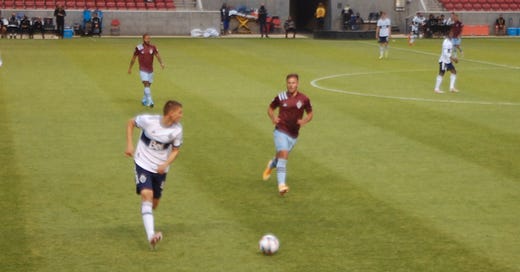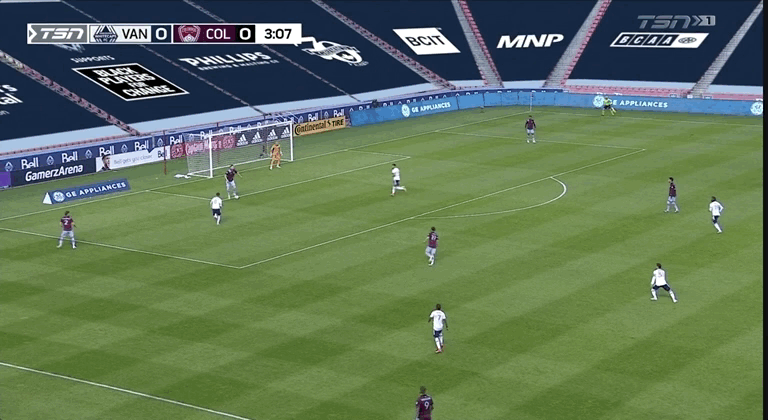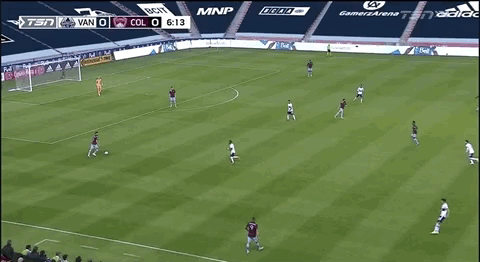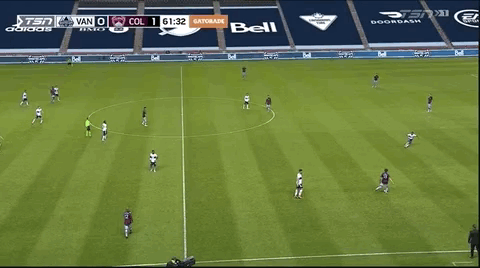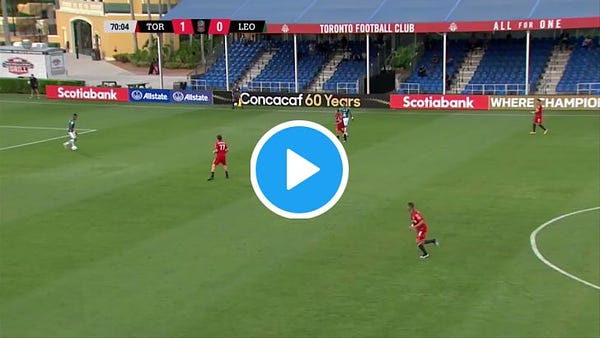Backpass: When Playing it Out of the Back Goes Right
The Rapids are using deep-end possession to their advantage. Will it last?

One time I was having a twitter soccer debate about youth development - this is one of the lowest, most aggravating circles of Dante’s twitter hell - and a person in the conversation was arguing about American orthodoxies regarding how we ‘must’ play moving forward. And in the argument he decried the idea that PIOOTB was a complete ideology that a coach could bring in to help paper over the cracks of the other deficiencies in American training and tactics. To which I replied ‘What’s PIOOTB?’ Despite three years of coaching, five years of writing, and multiple coaching clinics, I did not know what this meant. He replied ‘Playing It Out Of The Back’.
For those that are newish to soccer tactics, first: welcome! Second: oh my God, I’m so sorry - if you can, get out now while you still can. And third: playing it out of the back is a mid-2000s development in American soccer. Until then, American soccer was often called ‘direct’ or ‘route one’, meaning ‘we aren’t as technically able as other countries - we can’t tiki-taka like Spaniards or dribble out of trouble like Brazilians or knock MFers over like Argentinians en route to goal. We are fast, though, so we’re going to lope the ball deep, run after it, get close to goal and shoot.’ This produced results, particularly for high school and college coaches, and also a lot of bad soccer. Especially in international competition, it was known that you could ‘press’ the USMNT - sending forwards into the final third to try and steal the ball - and they’d panic, unload deep, and turn it over 50% of the time. Don’t check me on this, but I hazard to say the US men’s team had less possession of the ball in every game they played at the 1994, 1998, 2002, 2006, and 2010 World Cups. We didn’t know how to PIOOTB.1
At some point the powers that be in American soccer said ‘this is dumb.’ And the focus then became teaching soccer players to build an attack by (this sounds really obvious) working on passing skills and possession. And so we got better at it.
Last week, Austin beat the Rapids, in part, by pressing them effectively and watching Colorado crumple under the pressure. I covered it extensively in last week’s Backpass, but it was a ($) subscriber exclusive. He’s a shorthand of what we got into:

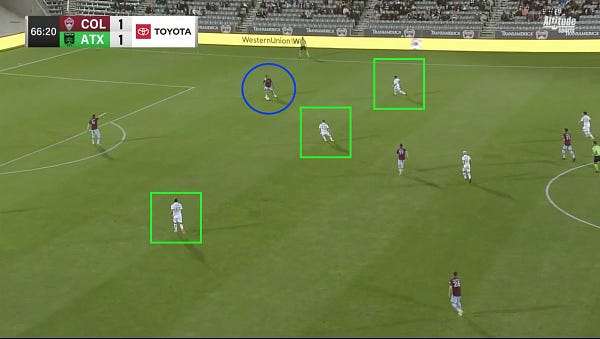
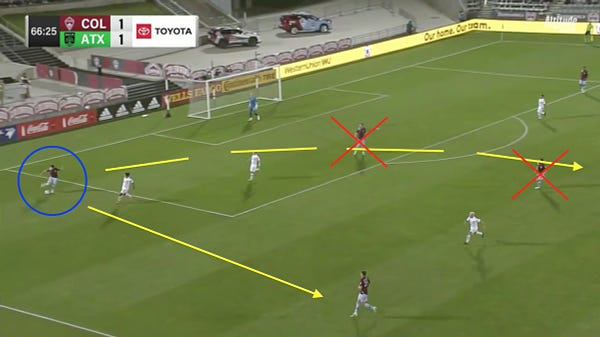

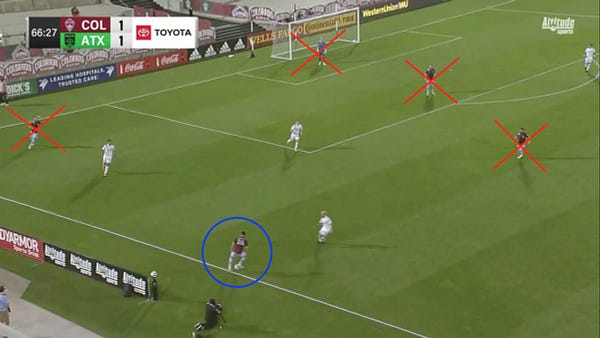
These pics were from the fateful second goal Colorado conceded against Austin. In each frame, Austin forced the Rapids into a situation with fewer and fewer solutions available. Finally, in the second to last frame, Keegan Rosenberry is in a spot where he has two options: kick it long or pass it to Cole Bassett. He goes to Bassett, who has one option: field it cleanly and dribble out of trouble. He didn’t. Austin took the ball and scored.
If you become a team that opponents know are vulnerable when under the ‘high press’, you’re starting at a disadvantage. Every possession that starts at the back will require a long ball, and every long ball will require you to win an aerial duel just to keep possession. The alternative, trying to play out of the back when you suck at it, will often result in turnovers to strikers 20 yards for goal. That’s bad. You don’t want that.
In the olden days, it was perfectly fine to start four towering clumsy oafs along the backline, and expect that they’d handle the defense while your midfielders would handle getting the rock upfield. In modern football, you can’t do that. Every team is fit and presses well. Everyone has to be an exceptional ballhandler.
For Robin Fraser’s Rapids, it’s all that and more so. Colorado, as we discussed in our podcast conversation with Matt Doyle, are fluid. They want to move the ball around in such a way that the defense does not realize they’ve been set up to be exploited. And that is even the case when playing it out of the back. Robin Fraser is Snidely Whiplash, twisting his mustache and muttering ‘Fools! They’ve fallen for my trap!’
Fraser want the Rapids to suck in the defense, get them to lean forward and drift into places where they think they’re about to take the ball and transition into offense - and just then, snatch it back, work it around the defense, and spring into action while their opponent’s pants are down.
This, suffice it to say, did not happen in the Rapids 3-1 loss to Austin.
It *did* happen against Vancouver this past week, and it made all the difference.
Three PIOOTB’s
Here’s three examples of the Rapids getting pressed and playing it out of the back successfully.
Danny Wilson starts, plays to Jack Price - Price one-times it to Keegan Rosenberry in the right corner. Rosenberry sucks in the defender and rips a ground pass to Acosta, who pings to Price, who pings to Younes Namli. Two passes later, the Rapids get a final pass to Andre Shinyashiki who takes a shot that is saved by Vancouver GK Maxim Crépeau.
The Rapids ability to play out of the back here sucks in, then eliminates five defenders. This pattern would repeat itself through the first half - and it meant that the plan Vancouver had to beat us - pressing - was rendered ineffective.
Here’s #2:
Rosenberry starts, passes to Price, who is forced to go back to Rosenberry. He passes to Wilson. Wilson has a safe play to Austin Trusty, but he’s also got Sam Vines wingbacking his way up field. He hits him with the big diagonal, which cuts out six defenders and results in a 3-on-3 break for Colorado.
Wilson has assumed the mantle of ‘pocket passing defender’ from the Rapids former ball playing CB, Tommy Smith. And he’s really good at it. Yeah, Danny’s still prone to some defensive lapses, but Wilson can hit the big switch about as well as any centerback in MLS these days, and Fraser knows it and encourages it. And nobody has as silky-smooth a first touch at left back as Sammy V. This is, again, that Snively Whiplash shit, and it is fantastic.
This play ended in a corner kick to the Rapids. But again, do this, over and over again, you generate chances, and you get goals.
Number 3:
Vancouver, they are a’learning. They are pressing with two players up-front now, instead of three. But that makes their press pretty ineffective. The Rapids back three whip it around and end up with Jack Price, who has dragged a defender backwards, and the whole ‘Caps defense has scooched upfield and towards the ball. The Rapids have, once again, sucked the Whitecaps into Fraser’s Spinning Vortex of Doom. Price goes full Shropshire Pirlo, putting a 70 yard ball on a dime to 5’4” pocket-rocket Michael Barrios who is blistering forward. Barrios is unselfish at the far end and passes to Diego Rubio, who’s shot is stopped.
…
This is all good. I like it. If they can do this week-in, week-out, we’ve got a gimmick that will give this team an advantage over all opponents. Even if it doesn’t suck in pressing teams and create opportunities on the break, it will at least nullify opponents that like to press, and even cautious teams will press on occasion.
I am at least partially concerned that the Colorado Rapids have not, historically, been a team that can play out of the back reliably each week. We were a ‘defend, play it safe, dump and chase’ soccer team from 2011 to 2018. Fraser is trusting that the talent is there to play a high-stakes lightning-possession style. It worked against Vancouver. But let’s be honest - you can do a lot of stuff against Vancouver. We’ll see if it works down the road against more dangerous MLS teams like LAFC, Portland, and Seattle.
…
Now’s a good time to click ‘subscribe’ - for a newsletter of free content for all, or to help support all the HTHL media endeavors with an affordable paid ‘subscriber’ that gets you one bonus column per month.
…
Wait, what is this formation?
The Rapids play a 4-4-3 formation. Except:


This possession and passing graph expresses the average position of players when they are in possession of the ball. As you can see from the passing graph above, Rosenberry, Trusty, and Wilson function like a back three, while Sam Vines pushes up and Shinyashiki drops back to function as wingbacks.
It doesn’t matter what we call this formationally - what matters is that Colorado clearly sees that Sam Vines is an offensive weapon and uses him appropriately. He’s fast enough to recover if the team turns in over in a bad spot, and also you will often see Jack Price sliding over and filling in to help out in that spot if need be.
I dunno if I have a point really. I guess what I want to say is , if you find yourself at the Bulldog Pub, and the man and woman next to you get into a heated debate as to whether the Rapids play 5-3-2 or 4-4-3 or even 4-2-3-1, you can tell them to put their switchblades away because they’re both right. Everyone’s a winner. Also - keep an eye on this as the season progresses. Are we going to keep doing this consistently, and if so, will other teams catch on? Let’s hope at least this week that nobody for Minnesota United notices any of the things I’ve said today.
Thanks to Our Highliner of the Month
Thank you to our Highliner subscriber for the very merry month of May, JodyCRobins! Every subscriber helps defray the cost of podcast and web-hosting, and slips a few bucks in the jar allowing us to pay for life’s necessities like ESPN+, a VPN, and a six-pack of Left Hand Brewing’s Milk Stout. Note that if you own any of those corporations, Matt and I are both deeply committed to shilling for profit in the event that you’d like to sponsor our podcast. We would happily accept payment in ale.
Recommended twitter follow: @wpiootbgw , AKA ‘When playing it out of the back goes wrong’ - a delightful collection of soccer disasters from around the world. Kind of like the soccer version of the highlights from a NASCAR race - which is pretty much just car crashes. Here’s Club Leon WPIOOTBGW-ing against Toronto in CCL from two weeks ago:

